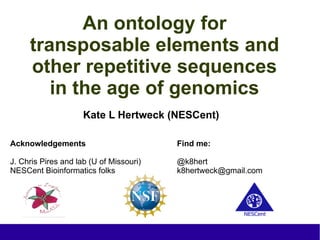
iEvoBio Hertweck presentation 2012
- 1. An ontology for transposable elements and other repetitive sequences in the age of genomics Kate L Hertweck (NESCent) Acknowledgements Find me: J. Chris Pires and lab (U of Missouri) @k8hert NESCent Bioinformatics folks k8hertweck@gmail.com
- 2. How can we effectively deal with repetitive elements? ● Repetitive sequences comprise a large portion of many genomes ● Characterization of repeats lags behind research of genes ● Descriptive biology: what's in a genome? ● Comparative biology: how and why do genomes vary? ● Ontology: how do we organize our conceptual framework for repeats? Class I: Retrotransposons Class II: DNA transposons Others LTR TIR Satellites LINE Crypton Simple repeats SINE Helitron ERV Maverick SVA Kate Hertweck, TE ontology
- 3. What makes repeats different? ● There are many classification schemes for repeats ● RepBase, lineage specific databases ● Organization based on evolutionary relationships (Wicker et al 2007) ● Repeats are difficult! ● Breadth of knowledge growing, but many black boxes remain ● Many copies throughout genome ● Difficulty in identification and annotation ● Lots of metadata necessary ● Organism sequenced: taxonomy, voucher ● Method of sequencing: next gen, sequence length, coverage ● Assembly method: ab initio, de novo ● Annotation approach: library, motif searching Kate Hertweck, TE ontology effects of junk DNA Evolutionary
- 4. Formalizing structure ● Developing the ability to summarize and compare repeat compliments from genomes of multiple organisms ● What is common between repetitive elements and genes/proteins/morphology? ● Does the age of a repeat matter? Fossils, inactivated, active but not inserting ● Relevant projects: ● Comparative Data Analysis Ontology (NESCent EvoInfo) ● Homology Ontology (Robison-Rechavi Lab) ● Suggestions welcome! Kate Hertweck, TE ontology effects of junk DNA Evolutionary
